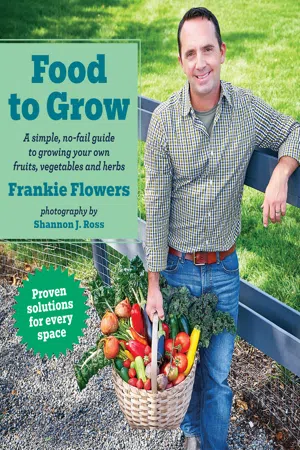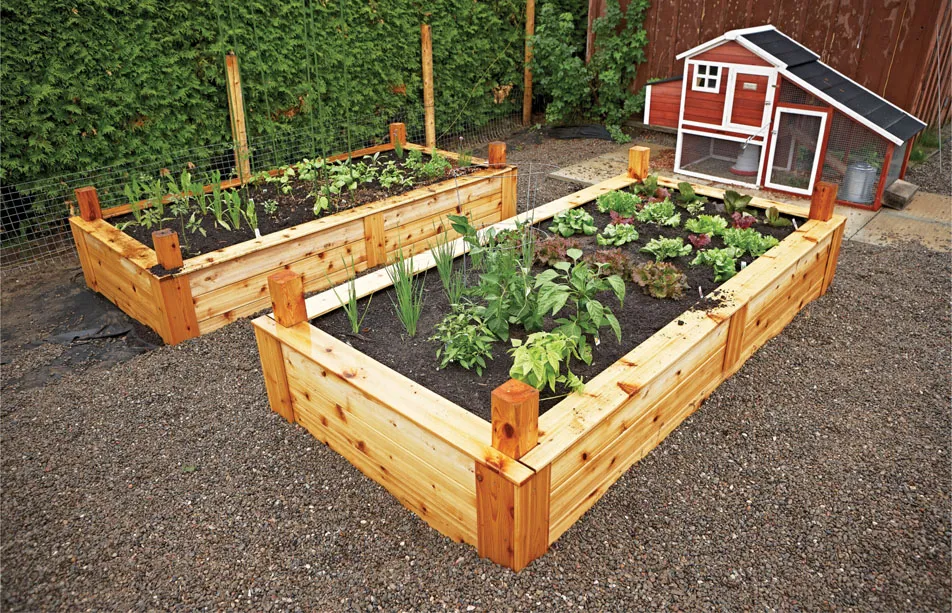Chapter 1
Food Basics: Where to Grow
Are you so ready for your new food garden that you can taste it? Whoa there. Before you create food-growing magic, you need to figure out just what kind of garden will work for you. Let’s face it, everyone would probably like to harvest from one of those sprawling plots you see out in the country, complete with a towering row of corn and vast pumpkin plants that will produce a perfect pumpkin in time to carve that jack-o’-lantern at Halloween. But do you really want to weed that big plot? Water it on sizzling summer days? Even if you do, maybe it doesn’t get enough sun or it’s a long walk from the water tap. The truth is, most of us don’t even have that kind of space.
Time to get real about how much sweat equity you want to put into gardening and what kind of approach suits your space. Maybe you can find a sunny corner in your yard, and it’s got the perfect soil and drainage for your crops. But maybe your soil is terrible or your sun only hits your patio. If so, you’re best off planting in containers.
I want you to get the most fruits and vegetables from the space you have with the least amount of work. Give me just a seed of passion, a scope of time, and a bucket of effort, and I’ll help you figure out what kind of garden suits you.
Raised beds look great in just about any yard—and plants thrive in them too.
Types of Food Gardens
Did you know there are two ways to garden? You can plant your food right in the soil for an in-ground bed. Or you can grow food—not just pretty flowers—in containers. And not just those round planters you can buy at garden centres and hardware stores. Troughs also make amazing food gardens. What is a trough? It’s a farm-issue steel or plastic container used to feed or water animals, and it can be repurposed. Troughs range in size from 15 to 250 gallons, and you can find them in garden centres or farm supply stores. (Used ones go for really cheap.) The steel ones look great in a modern-style yard.
As well, you can grow food in a raised bed. This is just a garden set on top of your soil, lawn, or patio. You build a wooden box, anchor it in the earth or place it on your patio, fill it with soil and plant in it. You’ll be able to tell from reading this book that I love raised beds! They warm up quickly in the spring, are easy to rig up with irrigation and frost protection, and they’re gentle on the old back when you weed them. You can hire someone to build you a raised bed, but they’re actually quite easy to put together on your own with basic materials from a home improvement store or a lumberyard.
While planning your food crops, you should decide if you’re an in-ground gardener or your plants would be better off in a container. If you don’t have a lot of land and are working with a porch or patio only, clearly you already know the answer! But sometimes the answer isn’t always so clear. Some of the factors I’ll cover next—things like sun exposure, soil type, and convenience—may influence your choice too. The following table shows the pros and cons of each type of garden:
Time and Commitment
Should you go for the big in-ground bed or just try a few containers this year? Your schedule and how much time you have to get down and dirty in the dirt will make the decision for you. Gardening is work! It’s fun work, but it does need time over several months.
If you’ve got a busy season ahead of you and a lot going on in your life—a big work project, a new baby, a major household renovation—take that into account when organizing your garden. Whatever you do, don’t forget your travel plans. If you have a cottage, are going on a long road trip, or know you’ll be away during the harvest, be sure you can get help from a neighbour or a local teen you can pay to water, weed, and pick ripe produce while you are gone.
How much time do you need? According to a 2009 study by the National Gardening Association, U.S. households who grew food spent an average of five hours per week gardening. And 5 per cent spent over 20 hours every week. I say people with very small container gardens can get away with just an hour a week of gardening. But if you have more, such as a 1 by 2.5 m (4 by 8 foot) garden or a trough or two, you should devote half an hour to gardening every day. If you can’t garden daily, you can make up time on the weekend.
And it’s not just about time. You can make time for something you love. How you feel about gardening is going to affect how often you’ll get outside and tend your plants.
Growing in Window Boxes
Rectangular window boxes—the ones that hang off windows or the ones you place on your patio railings—are lovely for annual plants. But they’re not my favourite for food gardening. Small, narrow window boxes dry out quickly and don’t hold enough soil for many plants. Exceptions: Smaller leaf lettuces such as mesclun mix or arugula will thrive with regular watering. If window boxes are your only option, look for containers that are at least 20 to 30 cm (8 to 12 inches) deep. And please, water them like crazy.
What Kind of Gardener Are You?
Everybody’s different, but there are four general types of gardeners. See where you fit, to help you make decisions:
Passive gardener: Loves the idea of gardening but isn’t the hugest fan of pulling out the hose or those pesky weeds. Will put in less than an hour per week.
Garden snacker: Adores a nibble of gardening. Usually, snackers love gardening early in the season, but then life gets in the way. Will devote up to three hours a week on the garden in the spring, but up to three hours every other week in summer.
Place food-growing pots along a walkway so they’re right at hand for weeding, watering, and harvesting.
Garden enthusiast: Would garden more if not for the rest of the things on that to-do list. Will devote two to five hours weekly to the garden.
Avid gardener: Lives, breathes, eats, and sleeps plants. Gardening is not a pastime but a way of life. Knows the name of every plant—even some in Latin! Devotes over four hours per week and is always up for more.
How Much to Grow
Bigger gardens take more work, period. If you like gardening but don’t love it, and you’re super-busy, don’t plant too much. The best approach, in my experience, is to start small and expand every season. A handful of containers this year could lead to a larger, in-ground plot next. And while there are no hard and fast rules about how big you should go based on your available time, I can give you a good idea of where to start:
• Passive gardener: No more than two 40 cm (16 inch) containers.
• Garden snacker: Two to f...






